The Lord of the Rings survival game has dwarves reclaiming a post-apocalyptic Moria
Game director of Return to Moria, announced earlier this year, shares details about the LOTR co-op survival game.
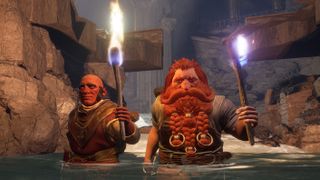
In the Third Age of Middle-earth, The One Ring was destroyed and Sauron vanquished. But it wasn't a time of celebration for the dwarves.
The underground kingdom of Moria, also known as Khazad-dûm, had plunged into ruin. As the story goes, the dwarves had dug too deeply in search of mithril and accidentally awakened the Balrog of Morgoth, who killed most of Moria's dwarven population and caused the rest to flee the most fabled of the dwarven realms.
Moria wouldn't remain empty for long as goblins, orcs, and cave-trolls plundered the city. Gandalf eventually defeated the Balrog, but as the Fourth Age began, Moria remained a stronghold of evil and darkness.
That's where The Lord of the Rings: Return to Moria picks up. The co-op survival game from Free Range Games and North Beach Games, announced this summer and releasing in 2023, is set in the Fourth Age as the dwarves set out to finally reclaim their kingdom beneath the Misty Mountains. As you might guess, mining, crafting, and base-building deep in the ruins of Moria won't be an easy task.
"Khazad-dûm is the site of a major catastrophe for the Dwarves," Return to Moria's game director Jon-Paul Dumont says. "And like any good post-apocalypse setting, nature has reclaimed much of it."
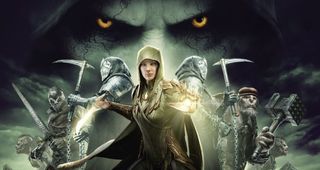
Dive into Middle-earth with our list of the best Lord of the Rings games.
That's not entirely a bad thing for the dwarves, as various subterranean creatures can be hunted for food and wild flora can be harvested in the cavern biomes. "There are abundant resources, especially for Dwarves, but they are hard to get to. The players will have to be clever to navigate its steep drops, collapsed tunnels and rickety platforms."
Navigating the ruins of Moria means contending with different hazards and environments. "A major part of the game is exploring the ruins of Khazad-dûm. That means city areas, caverns, mines, the darkest deeps and flooded chambers. Some lit naturally, some with ancient crystal and some totally dark. We're working hard on making sure the players will get a diverse set of environments to play in."
The biggest gaming news, reviews and hardware deals
Keep up to date with the most important stories and the best deals, as picked by the PC Gamer team.
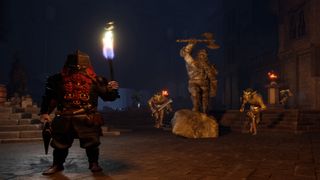
And of course the darkness is also filled with enemies, all those orcs, goblins, and trolls, the former servants of the vanquished Sauron who aren't ready to give up the ancient city.
"But Moria is not Mordor, so they are not going to be organized into an army, they will be more factional than we've seen before," Dumont says. "Part of the world building is also asking the question of how many orcs are left? What's going on with them after the fall of Sauron? They've had their dark lords disappear for millennia at a time before, do they believe that is what is happening again?"
Forging a path
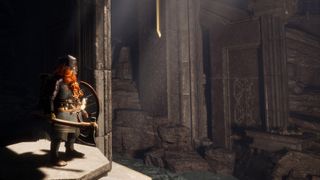
"Dwarves are a great fit for survival," Dumont says. "In the best games of the genre, players get nothing for free, they have to make everything themselves. This fits with the image of Dwarves being the ultimate crafters and builders. They can't help but fire up forges and start metalworking right from the beginning of the game."
Crafting is central in Return to Moria. "We're all about the fantasy of giant, hot forges as you hone your metalworking skills," Dumont says. Players will mine for silver, gold, iron, and much deeper down, mithril. Various plants can be harvested for experimentation in dwarven breweries, and these boozy crafting stations can be "multiple stories tall." Delving deep into Moria also means unearthing long-lost crafting recipes first discovered by dwarves thousands of years ago. "The deeper you go, the more wondrous technology you find from the height of the Dwarves' power," Dumont says.
"By the late game, a huge focus is not just building a base to survive but restoring the ancient architecture of Khazad-dûm. The kinds of building blocks the players will have range from small to colossal. So, if you are building from scratch, you can make your dream fortress. Or if you are rebuilding you can clean it up and add to it."
Surviving the Pit
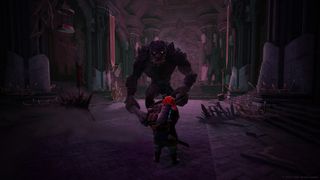
Along with familiar survival systems like hunger, energy, temperature, and the need for rest and sleep, there are two additional systems players will need to manage while toiling deep underground: light and noise.
Here's an exciting phrase for you: BEARD TECH.
"Darkness is a constant threat that can drain your will to continue, so you have to light the Black Pit," says Dumont. "The other mechanic that will get you in trouble is alerting the orcs by being carelessly noisy. Not to say it's a stealth game: after all, the Dwarves love to break rock and sing about breaking rock. It means choosing when to balance making noise and avoiding alerting the threats around them. Of course, if you eliminate the threat first, you can be as loud as you want."
Return to Moria is playable solo or with up to eight players, with scaled difficulty to provide a challenge depending on the size of each dwarven party. And as players make their way deeper into Moria, they'll discover more of the history of the ancient city.





Above: Gallery of concept art for The Lord of the Rings: Return to Moria
"The other major part of our game is the intersection between procedural generation and environmental storytelling," Dumont says. "Each biome will be arranged and generated differently for each server, but will also help tell the story of Khazad-dûm. It feels like a real place, with a thousand years of history layered into the rock."
If you're not interested in a dwarven history lesson, that's okay too, says Dumont. "If you want to learn more about Moria and Dwarves and what they eat and where they farm and who Durin II was, we will have that. If you want to just break rocks and break orc skulls, you can do that too."
Dwarf-building
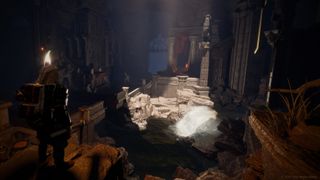
And as for your personal dwarven customization options, here's an exciting phrase for you: BEARD TECH. The words have been written on a Post-It on the Return to Moria board since the very beginning of development, according to Dumont.
"We've come up with some pretty stylish beards for players to choose, along with choices like color, adornments, piercings, scars and tattoos. Between the Dwarf Creator's body morph options, voice accents and customization of the crafted armor, players should be able to make any flavor of dwarf identity they want," Dumont says.
Dumont is especially excited for players to discover another system of Return to Moria: dwarven singing. "It's such a crucial part of the world Tolkien gave us. We have a whole soundtrack of original songs inspired by Tolkien's work, sea shanties, work songs, and jigs you can rattle off at the pub."
The Lord of the Rings: Return to Moria is planned for 2023 and will release on the Epic Games Store. If you're interested in more details, YouTube channel Nerd of The Rings hosted a chat with game director Jon-Paul Dumont and other members of the Return to Moria development team, which you can watch here.

Chris started playing PC games in the 1980s, started writing about them in the early 2000s, and (finally) started getting paid to write about them in the late 2000s. Following a few years as a regular freelancer, PC Gamer hired him in 2014, probably so he'd stop emailing them asking for more work. Chris has a love-hate relationship with survival games and an unhealthy fascination with the inner lives of NPCs. He's also a fan of offbeat simulation games, mods, and ignoring storylines in RPGs so he can make up his own.

Palworld developer reports Nintendo's suing over 3 Pokémon patents for only $66,000 in damages, but a videogame IP lawyer says fighting the lawsuit could mean 'burning millions of dollars'

No Man's Sky gets cross-save on a dozen platforms and brings back Mass Effect's Normandy as a limited-time rewar
Most Popular

